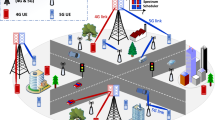Abstract
An advantage of time division duplex (TDD) wireless networks over frequency division duplex (FDD) is that the UL-DL switching point may be flexibly adapted to asymmetric traffic loads. This enables more efficient spectrum use, but on the other hand may lead to harmful cross-link interference between cells. As a result, the net gain (or loss) from flexible TDD depends on the traffic characteristics and network scenario. In this paper we address the problem in local area packet data networks, such as small- or femto-cell network, where high fluctuation in short term traffic loads is expected. We show through analysis and system level simulations that in such a scenario a significant gain in effective user throughput and packet delays may be achieved under low traffic loads. At high load the gain becomes smaller as packets accumulate in queues and there is both UL and DL traffic to transmit with high probability. When the UL and DL transmit powers are not balanced and switching point adaptation is applied the link direction with lower power may provide degraded performance. We show that introducing interference awareness at the scheduler provides more balanced performance and lowers the packet delays further.







Similar content being viewed by others
Notes
Cell edge TP is measured as the 5-th percentile of the TP cumulative distribution function (CDF).
This definition of capacity as a supported service rate vector is different from the information theoretic capacity. For instance, interference cancellation at the receivers is not assumed.
References
Astely D, Dahlman E, Furuskar A, Jading Y, Lindstrom M, Parkvall S (2009) LTE: the evolution of mobile broadband. IEEE Commun Mag 47(4):44–51
Bonald T, Massoulié L, Proutiere A, Virtamo J (2006) A queueing analysis of max-min fairness, proportional fairness and balanced fairness. Queueing Syst 53(1):65–84
Chan PWC, Lo ES, Wang RR, Au EKS, Lau VKN, Cheng RS, Mow WH, Murch RD, Letaief KB (2006) The evolution path of 4G networks: FDD or TDD? IEEE Commun Mag 44(12):42–50
Chandrasekhar V, Andrews J, Gatherer A (2008) Femtocell networks: a survey. IEEE Commun Mag 46(9):59–67. doi:10.1109/MCOM.2008.4623708
Chen CJ, Wang LC (2004) Suppressing opposite-direction interference in TDD/CDMA systems with asymmetric traffic by antenna beamforming. IEEE Trans Veh Technol 53(4):956–967. doi:10.1109/TVT.2004.830941
Cisco Systems Inc (2012) Cisco visual networking index: global mobile data traffic forecast update, pp 2011–2016. White paper. http://www.cisco.com/en/US/solutions/collateral/ns341/ns525/ns537/ns705/ns827/white_paper_c11-520862.pdf
Haas H, McLaughlin S (2001) A dynamic channel assignment algorithm for a hybrid TDMA/CDMA-TDD interface using the novel TS-opposing technique. IEEE J Sel Areas Commun 19(10):1831–1846
Holma H, Heikkinen S, Lehtinen OA, Toskala A (2000) Interference considerations for the time division duplex mode of the UMTS Terrestrial Radio Access. IEEE J Sel Areas Commun 18(8):1386–1393. doi:10.1109/49.864004
Holma H, Toskala A (2009) LTE for UMTS-OFMDA and SC-FDMA based radio access. Wiley, New York
Jänis P, Ribeiro C, Koivunen V (2011) Interference aware radio resource management for local area wireless networks. EURASIP J Wirel Commun Netw 2011. doi:10.1155/2011/921623
Jänis P, Ribeiro C, Koivunen V (2011) On the performance of flexible UL-DL switching point in TDD wireless networks. In: IEEE GLOBECOM workshop on femtocell networks, FEMnet 2011
Jeong W, Kavehrad M (2002) Cochannel interference reduction in dynamic-tdd fixed wireless applications, using time slot allocation algorithms. IEEE Trans Commun 50(10):1627–1636
Kim R, Kwak JS, Etemad K (2009) WiMAX femtocell: requirements, challenges, and solutions. IEEE Commun Mag 47(9):84–91. doi:10.1109/MCOM.2009.5277460
Kriengchaiyapruk T, Forkel I (2002) Adaptive switching point allocation in TD/CDMA systems. In: IEEE vehicular technology conference, VTC Fall 2002, vol 3, pp 1456–1460
Kushner H, Whiting P (2004) Convergence of proportional-fair sharing algorithms under general conditions. IEEE Trans Wirel Commun 3(4):1250–1259. doi:10.1109/TWC.2004.830826
Lembo S, Ruttik K, Tirkkonen O (2009) Modeling BLER performance of punctured turbo codes. In: International symposium on wireless personal multimedia communications, WPMC 2009
Nasreddine J, Lagrange X (2003) Time slot allocation based on a path gain division scheme for TD-CDMA TDD systems. In: IEEE vehicular technology conference, VTC Spring 2003, vol 2, pp 1410–1414. doi:10.1109/VETECS.2003.1207861
Omiyi P, Haas H, Auer G (2007) Analysis of TDD cellular interference mitigation using busy-bursts. IEEE Trans Wirel Commun 6(7):2721–2731
Wang LC, Huang SY, Tseng YC (2005) Interference analysis and resource allocation for TDD-CDMA systems to support asymmetric services by using directional antennas. IEEE Trans Veh Technol 54(3):1056–1069
WINNER II D1.1.2 (2007) WINNER II channel models
Author information
Authors and Affiliations
Corresponding author
Rights and permissions
About this article
Cite this article
Jänis, P., Ribeiro, C.B. & Koivunen, V. Flexible UL-DL Switching Point in TDD Cellular Local Area Wireless Networks. Mobile Netw Appl 17, 695–707 (2012). https://doi.org/10.1007/s11036-012-0405-z
Published:
Issue Date:
DOI: https://doi.org/10.1007/s11036-012-0405-z




